Candlestick patterns are the bread and butter of many traders, providing valuable clues about potential market moves.
While you’ve probably heard of the usual suspects like pin bars and engulfing candles, there’s an unsung hero lurking in the shadows:
The Spinning Top candlestick!
Frequently spotted on charts, the Spinning Top often signals a battle between bulls and bears, with neither side gaining a clear advantage. It’s a visual representation of market indecision. However, The Spinning Top doesn’t always mean what you think it does.
In this article, we’ll unravel the mysteries of the Spinning Top candlestick.
We’ll dissect its anatomy, explore the forces behind its formation, and reveal the subtle insights it offers into future price action.
Intrigued?
Breaking Down The Spinning Top Candlestick
Have you ever noticed a candlestick with a tiny body with upper and lower wicks about the same length?
They’re everywhere, right?
No matter the pair or time-frame, you’ll spot them constantly. In fact, they’re probably three times as common as other types of candlesticks – and that’s a lowball guess. Even though some traders might shrug these candles off as unimportant, they actually matter a lot.
These little guys are known as Spinning Top candlesticks, and they show when traders can’t make up their minds about price.
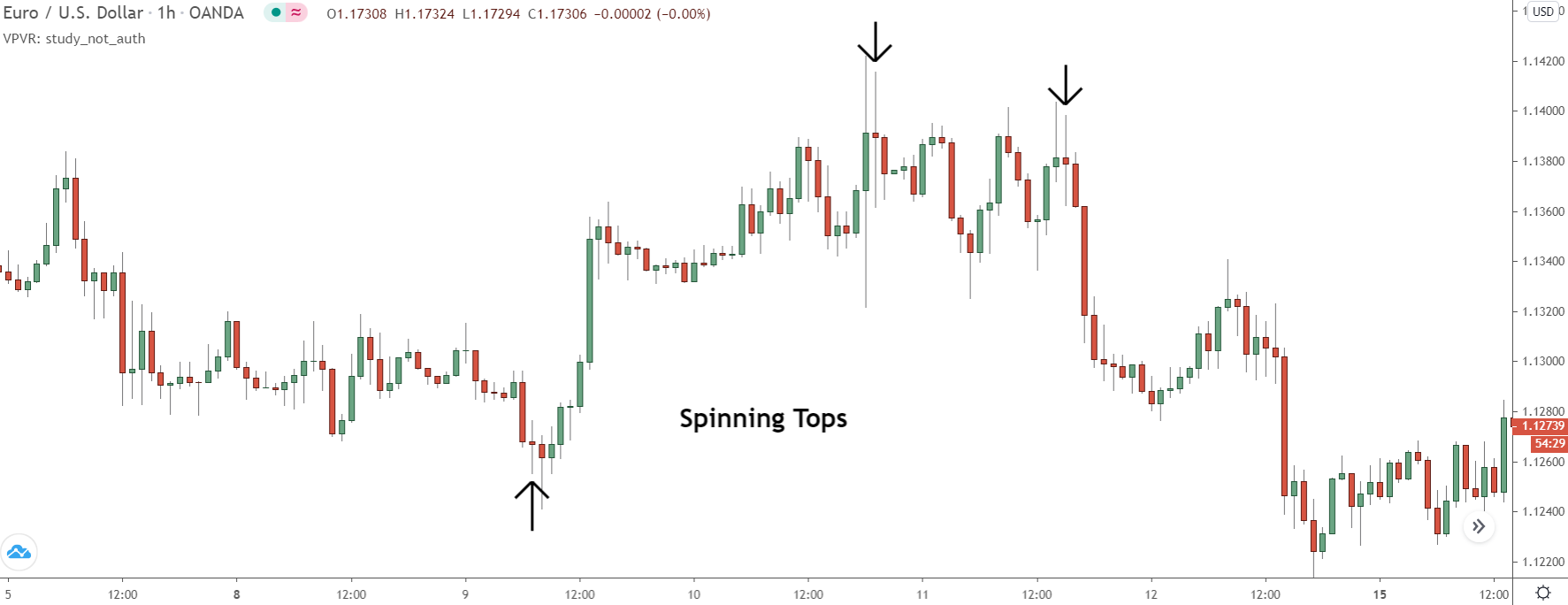
Spinning Tops form when the bulls and the bears are trying to take charge, but neither side can outdo the other.
Here’s how it happens:
First, the bulls push price higher than the opening price. That starts to turn the candle bullish. But then the bears are like, “Wait just a minute. We’re not cool with the price going up right now,” so they decide to sell, which lowers the price and forms the upper wick of the candle.
The bears think they’ve got the upper hand now.
They try to push the price down, but then the bulls step in and say, “No way, we’re going to push the price back up,” and they manage to get price back towards the open, forming a long lower wick in the process.
This tug of war continues; the bulls buy, the bears sell, the bulls buy again, and so on.
Eventually, it’s a draw.
Neither side can outdo the other, and the candle closes, leaving behind a Spinning Top.
Identifying The Spinning Top
Identifying a “Spinning Top” won’t be too hard for you. It’s a common candlestick pattern, which means you’ll see it all over your charts.
A Spinning Top can look slightly different each time, but they all share the same two traits:
- A small body in the middle of the candlestick.
- Upper and lower wicks (those skinny lines sticking out) that are about the same length.
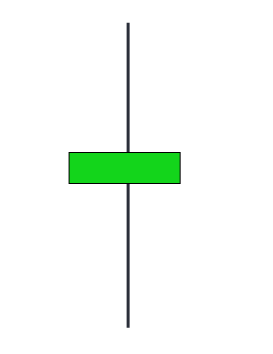
Sometimes, the body might be closer to one end than the other.
That’s not a big deal; it’s still a Spinning Top. It just means one side (the bulls or the bears) had a tiny bit more power, but not enough to totally win.
If the body is right at the end, though, it’s not a Spinning Top anymore.
We call those “Pin Bars.”
The length of the wicks can vary too – bigger wicks mean a bigger tug-of-war happened.
Spinning Tops hint a reversal (when prices change direction) might be coming. But remember, don’t take them as a signal to enter a trade.
The candles usually appear at turning points in the market, often near a recent high or low.
When you see a Spinning Top, it reveals the bulls (buyers) and bears (sellers) are in a heated battle – hence the large wicks. So, after you spot one, watch out for other signs of a reversal, like Pin Bars, support and resistance levels, etc.
Price might be getting ready to reverse or retrace.
Like all candlesticks, Spinning Tops can close bullish or bearish.
Some traders believe the way a Spinning Top closes predicts the price direction: for example, a bullish close means the price will rise.
But that’s not usually true – it depends more on where the top formed.
Even so, it’s pretty much a coin toss.
Key Features
Here are the essential features of a Spinning Top:
- Small Body: The main characteristic of a Spinning Top candlestick is its small body. This suggests there is little difference between the opening and closing prices, indicating indecision or a stalemate between buyers and sellers.
- Long Shadows: The upper and lower shadows (or wicks) of a Spinning Top are typically long, showing that during the trading period, prices swung high and low. However, they closed near where they opened, again suggesting a tug-of-war between buyers and sellers.
- Indication of Potential Reversal: A Spinning Top can be seen as a signal the current trend might be losing its strength. This is because it represents indecision in the market, which often precedes a trend reversal. However, Spinning Tops are more effectively used in conjunction with other technical factors as they don’t always guarantee a reversal.
- Color-Independent: The color (red or green, bearish or bullish) of the Spinning Top doesn’t matter as much as the shape and position. Regardless of color, a Spinning Top indicates uncertainty and possible change in the market.
- Context Matters: While a Spinning Top can indicate a potential change in trend, it’s crucial to consider its placement within the broader price trend. For instance, a Spinning Top occurring after a long bullish trend may signal the bulls are losing control and a bearish reversal may be on the horizon.
Always remember, while Spinning Tops can provide valuable insight, they should be used in combination with other factors for more accurate predictions.
How To Use Spinning Tops In Your Trading
Spinning Tops might not seem as useful as other common candlestick patterns, like pins, engulfs, inside bars, and so on. However, they can still give us useful hints about what’s happening between the buyers (bulls) and sellers (bears) in the market.
Here’s how I usually use them…
Best Way To Use Tops: Early Reversal Signals
Spinning Tops aren’t great for deciding when to enter a trade, so avoid using them for entry signals. You’ll just lose money and be left wondering why things didn’t go as planned.
The best way to use tops:
As an early warning signal the current price movement might be about to change, and price might start to reverse or pull back.
Some people say Spinning Tops show uncertainty or indecision in the market, which is true… But they also show that one side of the market (either the bulls or the bears) thinks the current market price is too high or too low.
For example:
If price is rising and a Spinning Top forms, it shows the bears have jumped in and started selling to fight back against the bulls.
The bears don’t want price to keep rising, so they sell to stop the price from moving higher.
So, we can use Spinning Tops as clues to figure out if price might be about to reverse or pull back.
If the bears are selling to stop price from rising, which causes a Spinning Top to form, we know one side of the market doesn’t want price to keep rising – therefore, a trend reversal or a pullback to the current trend could happen in the near future.
So, we just wait for a Spinning Top to form, then?
Well, not exactly…
Spinning Tops can signal a reversal, but they often don’t – sometimes price just slows down or pulls back a little after they form, without really reversing at all. Obviously, we want to avoid these tops and focus on the ones most likely to lead to a real reversal.
But how do we do that?
It’s actually pretty easy:
We just focus on the tops which form around important technical levels – like supply and demand zones, support and resistance levels, fibs, etc.
These are the areas where lots of buyers and sellers are active.
When we see a top forming around one of these levels, we know there are many people who think price is too high or too low – more so than at any other point during the move. That makes a reversal much more likely, making the Spinning Top a better signal.
So, it’s pretty simple – just look for a Spinning Top when price hits an important level or moves into a supply or demand zone.
Then you’ll know a reversal might be coming.
Let’s look at an example…
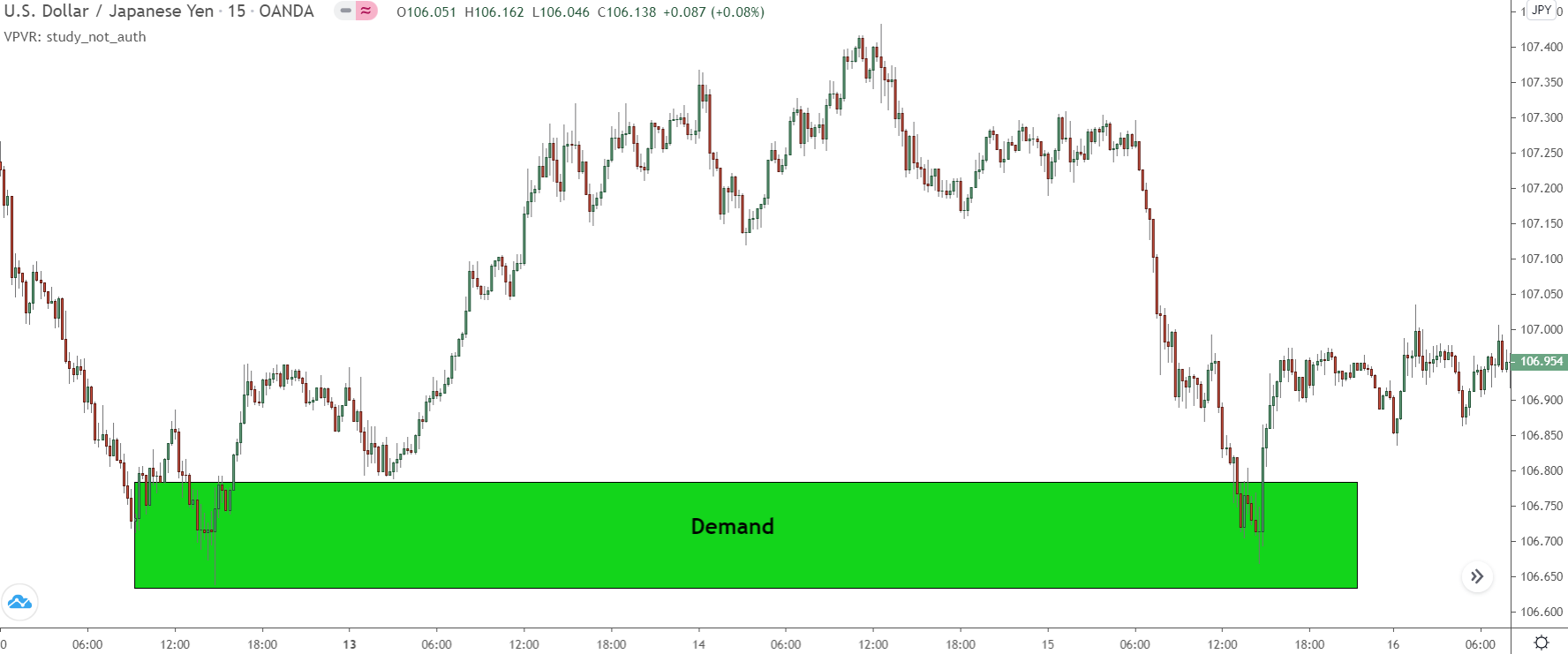
You can see price has just fallen into a strong demand zone.
We’re not sure yet if price will reverse from this zone.
We must wait for price action signals – like pin bars, engulfs, and so on – to make sure price is ready to move the other way.
Then we can jump in and try to catch the reversal, fingers crossed.
In the meantime, though, we can look for a Spinning Top…
When a Spinning Top appears at a key point, it tells us the sellers (or buyers in our case) think price is too low or too high.
This usually means price could reverse soon.
One or more Spinning Tops helps us: #1 know price still might reverse in the zone, and #2 figure out when we should expect a price action entry signal to form.
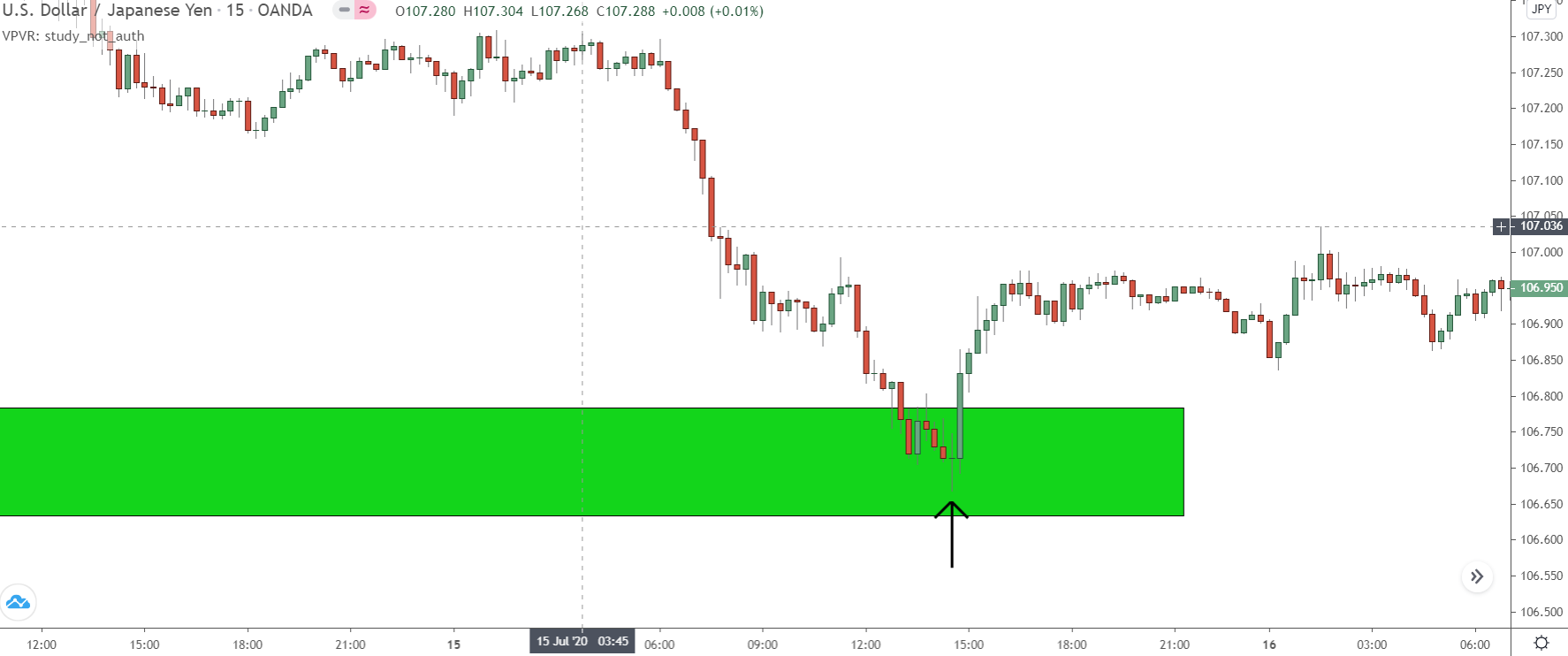
A Spinning Top appears 4-5 hours after price enters the zone – some might call this a Doji Candlestick, but it’s actually a Spinning Top.
With the top, we know buyers still think price is too low.
When price first moved into the zone, a bullish candle appeared, but then it went south. So, we weren’t sure if buyers were still interested or if the zone would trigger a reversal. This top gives us a thumbs-up, telling us, “YES, buyers are still here, keep your eyes peeled.”
In this case, we didn’t actually get a chance to jump in – after the Spinning Top, price reversed and rocketed higher.
But, we did get a sign the zone was a good place to enter long and a heads up a potential reversal might start soon… which was a valuable hint we could use to our benefit.
So, remember this when you see spinning tops at important technical levels.
These tops tell you buyers or sellers are interested in the price reversing – why else would they start a tug-of-war with the other side? It also tells you a reversal signal might be close… not necessarily on the next candle, but soon on the time-frame you’re looking at.
Now, let’s move on and check out a few key things to remember about the spinning top.
3 Facts To Remember About Spinning Top Candlesticks
Before you head off and start looking for Spinning Tops, here are three key things to keep in mind about what they indicate and how important they are.
#1 Always Use Multiple Candles To Confirm Signals
A lone Spinning Top doesn’t tell you much about what’s happening with price.
It only shows the bulls (or bears, based on the previous direction) have entered the market and are ready to wrestle with the other side. If you want to make sure the tops hint at a possible reversal or small pullback, you need to wait for other signs to show up as well.
For instance…
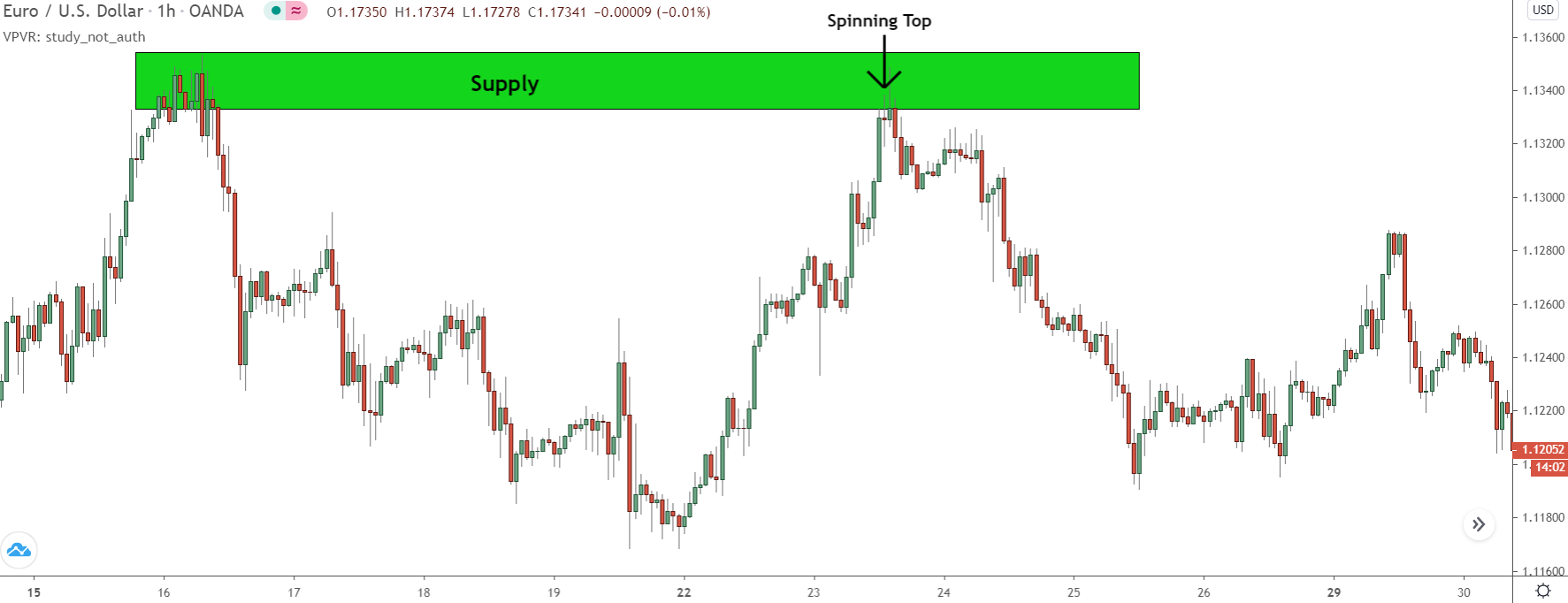
When price first reaches this supply zone, a Spinning Top with two large wicks forms.
The top reveals the bears are ready to duke it out with the bulls again, suggesting a reversal could be just around the corner.
But hold up!
The spinning top doesn’t give us a solid signal because we can’t be sure if the zone will hold or not. We need to wait for more signs price might be about to flip before we jump into a trade.
One hour after the Spinning Top appears, a large bearish Pin Bar (another candlestick pattern known for signaling a reversal) forms. This adds further confirmation price is likely to reverse. So, this would be your cue to enter short.
The Spinning Top hinted at the flip, and now the Pin Bar confirms it.
And check out what happened later, too…
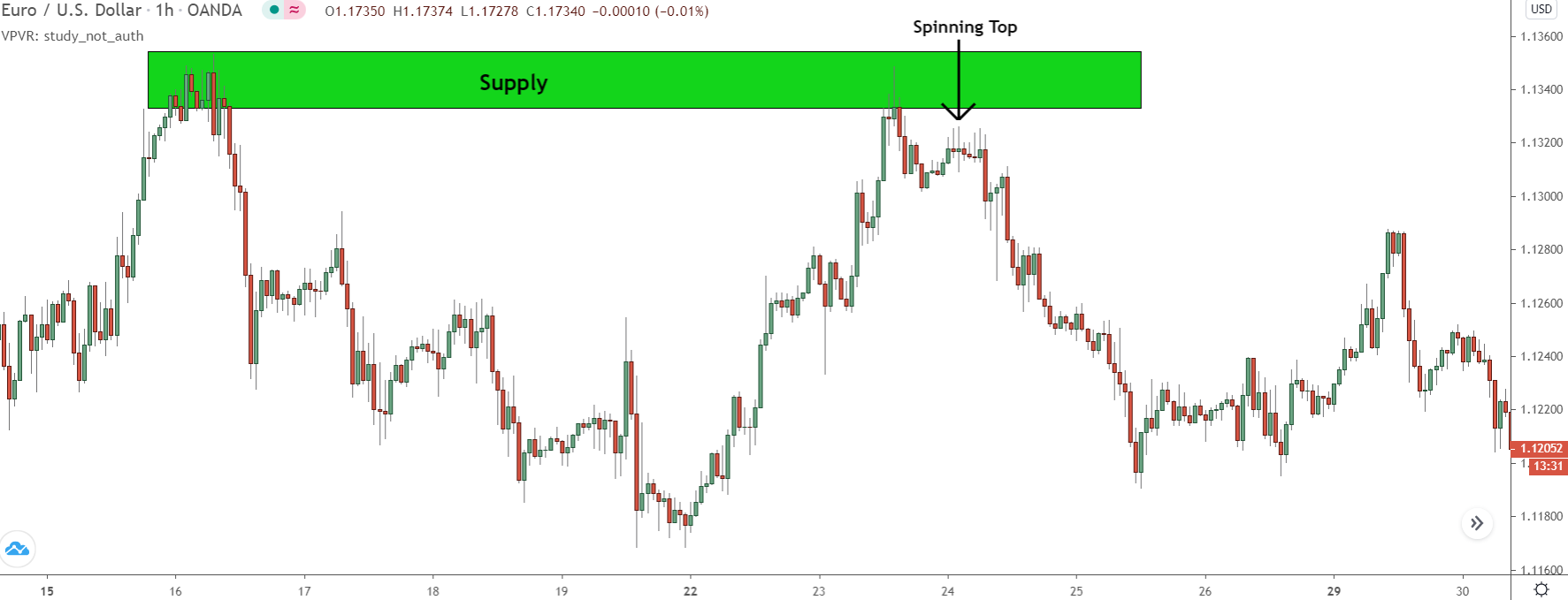
Price drops and a bearish engulf forms, which is a sign price could be about to reverse, making it a great entry signal short.
Then price begins to move sideways, and another spinning top appears.
This tells you that there’s a real tug-of-war happening between the bulls (the buyers) and the bears (the sellers), hinting a reversal could be near.
You don’t know in which direction, but since there was a recent drop, you’re betting price is going to keep falling, so you hang tight and watch the action unfold. A couple of hours later, three large bearish Pin Bars form, indicating the bears probably have the upper hand and price could be about to drop, which it does.
Pretty straightforward, right?
Remember: Always combine this with what I explained in the previous section.
Spinning tops that form at support and resistance levels, supply and demand zones, or fib retracements have a higher chance of hinting at a reversal.
Think of them as a warning sign price might reverse from the current level or zone.
Then, look for confirmation using pin bars or engulfing candles.
This will help you predict when the price might reverse from a level or zone.
#2 Daily Spinning Tops Are More Significant
Spinning Tops are considered more important when they form on the daily time-frame; they include more buyers and sellers, so their battle is bigger and more important for the market.
This might sound kind of boring, but it can really help you out…
If a Spinning Top forms on the daily, you know a major showdown is happening.
Whichever side has entered the market to wrestle with the other side REALLY doesn’t want the price to keep going in its current direction.
So, what do you think will happen if they lose?
Price is going to make a BIG MOVE.
If they lose the fight, price will make a quick jump because there’s no one left to hold it back. That liquidity (the bulls or bears wrestling with each other) has been removed from the market, so price must continue in it’s current direction until more buyers or sellers show up.
You can see a perfect example of this in the picture below…
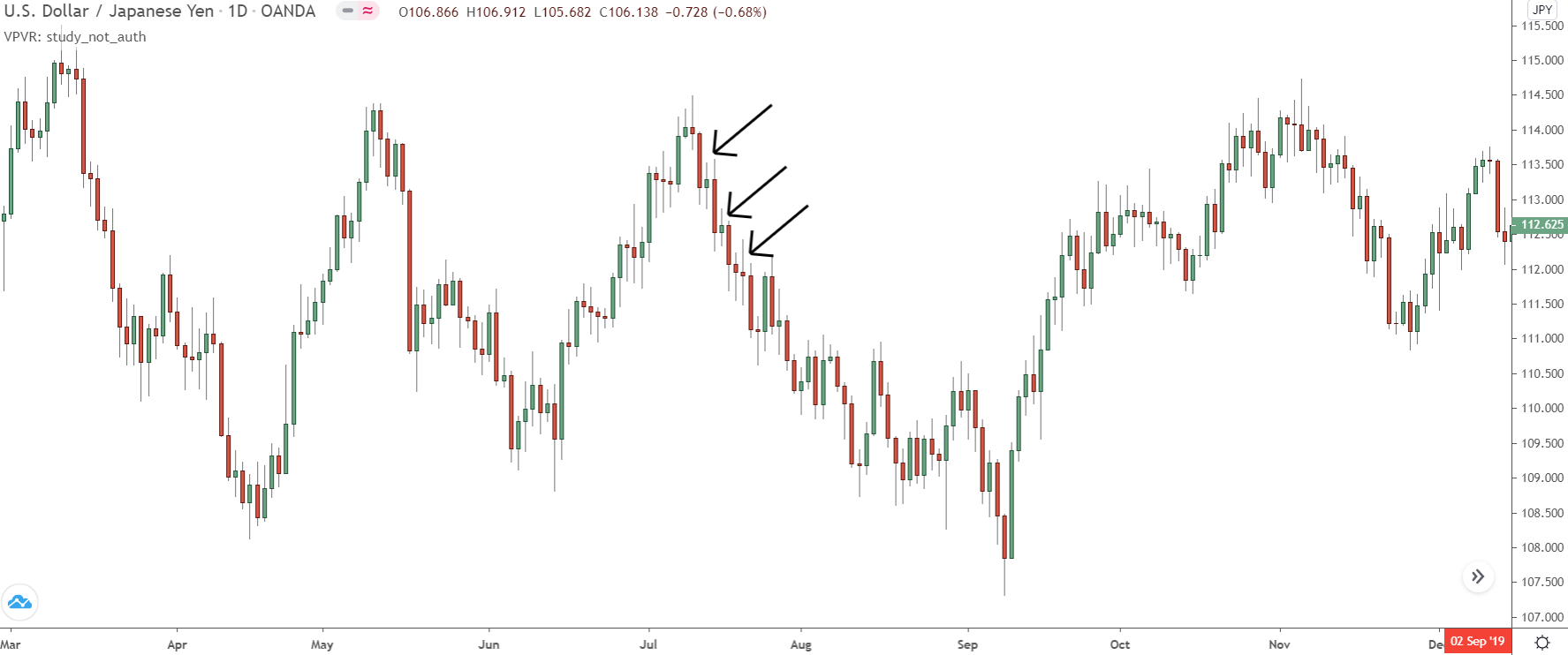
During the decline above on Usd/Jpy, three Spinning Tops appeared, which was then followed by a significant decline in the downtrend.
Each top shows a fight between the buyers (bulls) and sellers (bears); the bears wanted price to keep falling, and the bulls wanted price to rise. Each time, the bulls lost the fight. Once that happened, no buyers were left to stop the price from falling, so it fell quickly before another fight started at a lower price.
Got it so far?
Now, how do we use this info for our own trading?
I think the easiest way is just to know when a large rise or decline could be about to happen.
How many times have you seen a sudden dramatic rise or fall in price. Lots of times, right? And I bet many of those large moves happened right after a one or more Spinning Tops appeared.
Knowing a large price change could be coming is also helpful in other ways…
If you’re selling and a Spinning Top shows up – signaling another large decline might be coming – you can try to sell again on a lower time frame, to increase the amount of money you make. You also know to take some profits off, just in case the price moves against you.
These are just a few of the things you can learn from seeing a Spinning Top form, which is why I think it’s one of the most important signals to watch for.
#3 Spinning Tops Don’t Show A Reversal, Just A Pause
This is important, so I have to mention it.
Lots of traders get this wrong about the Spinning Top and it’s a big reason why they lose money.
A Spinning Top doesn’t mean the trend is reversing; it just means there’s a pause in the market.
The bulls or bears that were in control during the previous move have come back into the market and are fighting it out again for control of the price.
- Bulls think price is too low and want it to rise.
- Bears think price is too high and want it to fall.
Whoever wins will control the price, but you won’t know who from the Spinning Top. That’s why you should never use it as a sign of a reversal. The Spinning Top doesn’t show who won, only that there was a fight! You have to wait for the next few candlesticks to see who’s in control of the price now.
So, don’t use Spinning Tops as reversal signals – they don’t work.
Wait and see what the price does over the next few candles to find out who won the fight.
If another candlestick shows a clear winner, that’s a good sign of who won. If another spinning top shows up, the bulls and bears are still fighting; wait and see what happens next.
The Bottom Line
I’ll be the first to admit Spinning Tops aren’t the most useful candlestick pattern that forms in forex.
The tops aren’t as clear as other signals, like Pin Bars and Engulfing Candles, which give us a better idea of what’s coming next. But, they can still give you some really helpful information, which I hope you’ve learned from this post.

I am not able to pay to become a VIP, it keeps declining. Please could you help to get this sorted. I also tried to fund a way to contact by email or any other sort however the contact details aren’t there on the website. I hope you will reach out to me soon thank you